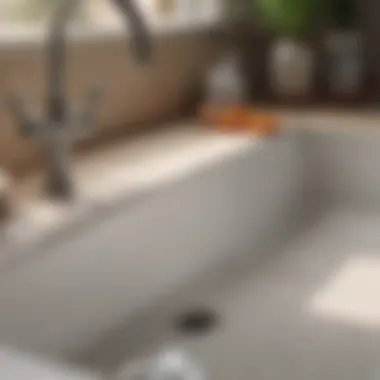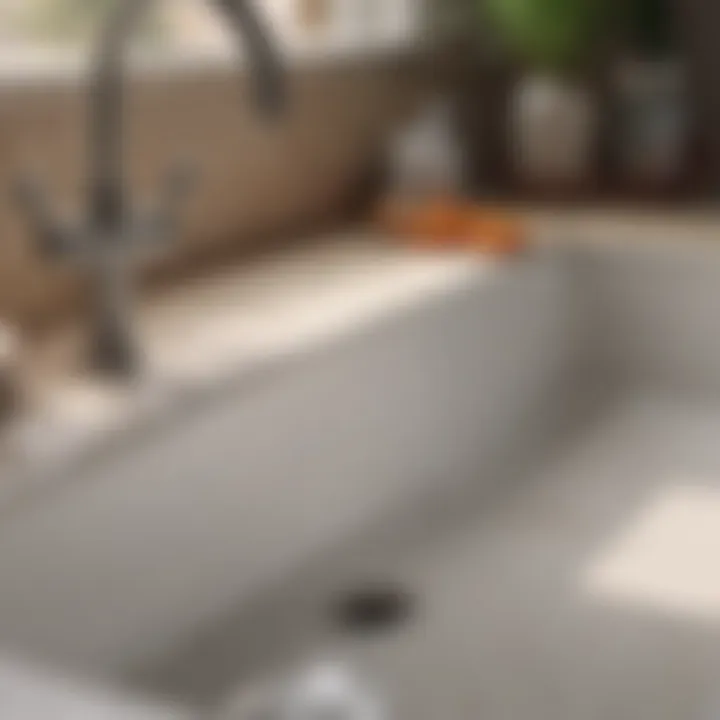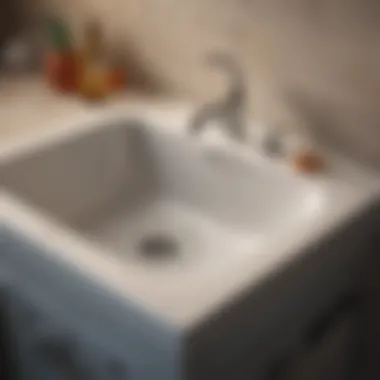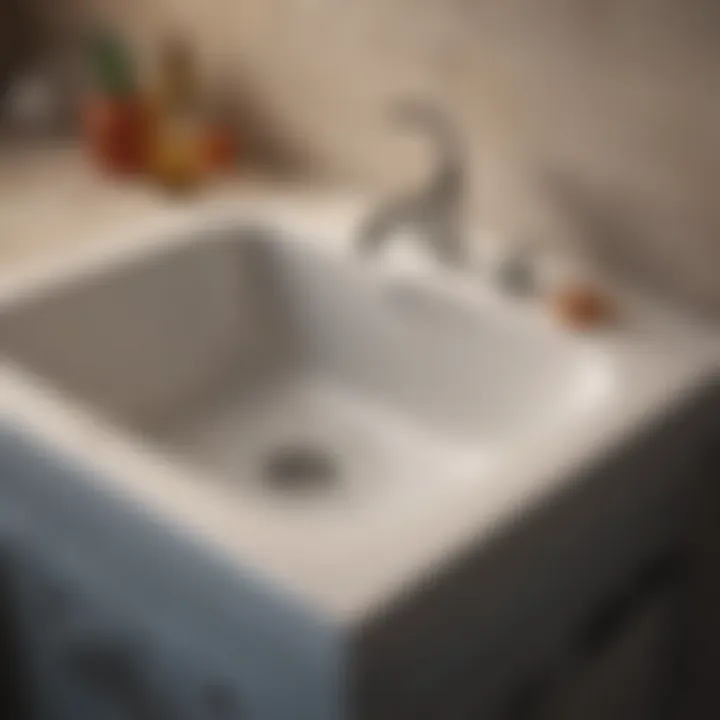Natural Remedies to Unclog Your Sink Effectively


Intro
Clogged sinks are an all too common household issue. They can disrupt daily routines, leading to inconvenience and frustration. While many people reach for commercial drain cleaners, these often contain harsh chemicals that are not only harmful to the environment but can also damage plumbing systems. This guide aims to present effective natural remedies for unclogging sinks, providing both practical solutions and sustainable choices.
In this comprehensive exploration, we will delve into the science behind common household ingredients that can effectively clear blockages. Additionally, we will compare traditional plumbing methods with eco-friendly alternatives. By prioritizing natural solutions, homeowners can address their plumbing issues without compromising their environmental values. This analysis will help readers understand the benefits and limitations of each approach, thereby equipping them with practical knowledge to tackle such household challenges.
Understanding Clogged Sinks
The discussion about clogged sinks is vital given its implications for everyday life. Everyone experiences a sink blockage at some point. It disrupts the flow of daily activities and can lead to unwanted mess and stress. Understanding the factors behind a clogged sink is essential for effective remedy application. This knowledge helps in identifying the root cause of the issue and deciding which natural remedy to employ.
Common Causes of Sink Clogs
The reasons behind sink clogs can be simple yet diverse. Most clogs result from the accumulation of debris over time. Food particles often collect in kitchen sinks, while hair and soap residue can build up in bathroom sinks. The following points elaborate on common causes:
- Grease Buildup: Grease from cooking can solidify in pipes, leading to slow drainage.
- Soap Residue: Over time, soap scum can harden and obstruct water flow.
- Hair Accumulation: Hair can trap other substances, forming a larger blockage.
- Foreign Objects: Small items like jewelry or food scraps can become lodged in pipes.
Understanding these causes can lead to proactive measures for preventing clogs. Regular cleaning and avoidance of certain practices can also maintain clear drainage.
Signs of a Clogged Sink
Awareness of the signs indicating a clogged sink can lead to timely interventions. Ignoring these signs may result in more significant issues. Key indicators include:
- Slow Draining: Water takes longer than usual to drain, signaling a potential blockage.
- Unusual Noises: Gurgling sounds may indicate air trapped by a buildup.
- Foul Odors: A bad smell can suggest decomposing material within the pipes.
- Water Backup: If water starts to pool instead of draining, this is a clear sign of clogging.
Recognizing these symptoms early on can prevent further complications, allowing for effective natural remedies to be deployed in a timely manner.
"Being informed about your plumbing can save not just time, but also costs associated with fixes and damages."
Recognizing the signs and understanding the causes lay a solid groundwork for the pursuit of natural remedies. This knowledge serves as a prelude to more advanced treatment methodologies.
Prelims to Natural Remedies
In the realm of home maintenance, the topic of natural remedies holds significant importance. Homeowners increasingly seek methods that are not only effective but also align with more sustainable practices. The essence of using natural remedies lies in their approach to unclogging sinks without relying on harsh chemicals. This article will explore a variety of techniques, each rooted in common household items. Understanding natural remedies can empower individuals to tackle plumbing issues, reducing the dependency on commercial products that often come with environmental costs.
The allure of natural solutions spans several key elements. First, natural remedies often utilize readily available materials. Items such as vinegar, baking soda, or salt are staples in many kitchens. They provide straightforward solutions that can save both time and money. Moreover, these methods tend to be less harmful to plumbing systems and the environment. Chemicals can corrode pipes and contribute to broader environmental issues, while natural ingredients offer a safer alternative.
Another consideration is the health aspect. Many commercial drain cleaners contain toxic substances that can pose risks to human health. In contrast, natural remedies typically use non-toxic ingredients that are less likely to cause adverse effects. This not only promotes a safer living environment but also fosters a holistic approach to home care.
However, it is essential to recognize that natural remedies have limitations. They may not be suitable for all types of clogs, and their effectiveness can vary depending on various factors, such as the severity of the blockage and the materials involved. Understanding these nuances is vital for homeowners aiming for successful results.
The following sections will delve deeper into the benefits and limitations of these natural solutions, providing insights that equip readers for effective home maintenance.
Vinegar and Baking Soda Method
The use of vinegar and baking soda as a natural remedy for clogged sinks combines acidic and basic properties to create an effective, eco-friendly solution. This method is significant as it not only addresses clogs but also promotes sustainability. Many homeowners are seeking alternatives to harsh chemical drain cleaners that pose risks to both plumbing systems and the environment. By utilizing common household items, vinegar and baking soda can provide a straightforward and non-toxic alternative.
Chemical Reaction Explained
The magic behind this method lies in the chemical reaction that occurs when vinegar, an acid, interacts with baking soda, a base. When these two substances mix, they produce carbon dioxide gas. This gas can help dislodge debris and clogs in kitchen or bathroom sinks. The bubbling action may lift and break apart the buildup, allowing it to flow down the drain. Understanding this reaction reinforces the benefits of using non-toxic remedies in maintaining a clean and functioning plumbing system.
Step-by-Step Process
To efficiently use the vinegar and baking soda method, follow these simple steps:
- Prepare the Area: Clear any items from around the sink to avoid spills.
- Remove Standing Water: If possible, remove any excess water from the sink, as this will help the solution work more effectively.
- Add Baking Soda: Pour about half a cup of baking soda directly into the drain.
- Add Vinegar: Follow up with half a cup of vinegar. If desired, use a funnel for easier pouring.
- Cover the Drain: Place a stopper or cloth over the drain to trap the gases inside, maximizing the effect.
- Wait: Allow the mixture to sit for at least 30 minutes. This waiting period ensures that the reaction can work on the clog.
- Flush with Hot Water: After 30 minutes, boil some water and carefully pour it down the drain to flush away the dislodged debris.


By adhering to these steps, homeowners can harness the effectiveness of vinegar and baking soda for unclogging sinks.
Projected Effectiveness
The effectiveness of the vinegar and baking soda method can vary depending on the nature and severity of the clog. For minor clogs caused by grease and soap buildup, this remedy can work quite well. It's low-cost and safe for most types of plumbing.
However, it might not work on severe blockages or those caused by foreign objects. As a general guideline, repeat this method weekly for regular maintenance to prevent clogs from forming. While the method is usually safe and effective, persistent problems may require more advanced solutions.
Salt and Hot Water Technique
The salt and hot water technique serves as an alternative approach to traditional drain unclogging methods. This method relies on two very common household items that are effective in breaking down debris. Salt acts as an abrasive substance that helps dissolve some types of blockages, while hot water aids in moving solids along the drain. This technique appeals to those seeking a more environmentally friendly solution for maintaining their plumbing systems.
How Salt Works on Clogs
Salt functions effectively on clogs due to its crystallinity and soluble nature. When salt is introduced to a clogged drain, it can interact with the water and other materials accumulated in the pipes. The rough texture of the salt grains can help scrub away some of the more stubborn debris lining the pipes. In addition, salt can work to break down grease and fats. Fatty substances often contribute to clogs, and when combined with hot water, salt can help in emulsifying them, allowing for easier removal.
Implementation Steps
Executing the salt and hot water technique can be straightforward. Here is a step-by-step breakdown:
- Gather Materials: You will need table salt and a kettle or pot to heat water. A measuring cup might also be helpful.
- Boil Water: Heat approximately two to three cups of water until it reaches a rolling boil. Be cautious not to let it boil over.
- Add Salt: While the water heats, measure about half a cup of salt. You can use regular table salt or even coarse sea salt, depending on what you have available.
- Pour Salt Down the Drain: Once the water is boiling, carefully pour the salt into the drain. You can let it sit for a few minutes to start working on the clog.
- Follow with Hot Water: Next, gradually pour the hot water into the drain, creating a more aggressive wash down the pipes. This step is crucial as it activates the salt's cleaning effect.
- Repeat If Necessary: If the clog doesn’t clear after the first attempt, you may repeat the process once more for better results.
Utilizing the salt and hot water technique can provide an effective, simple way to address minor sink clogs, emphasizing the importance of eco-friendly cleaning methods. It is advisable, though, to use this method judiciously on a regular basis to help prevent severe blockages from forming.
Dish Soap and Hot Water Combination
The combination of dish soap and hot water presents a practical and efficient solution for addressing clogged sinks. This method utilizes common household ingredients that many homeowners already have on hand. By employing this technique, one can avoid the use of harsh chemical drain cleaners, making this both an environmentally friendly choice and a safer alternative for households with pets or small children.
Rationale Behind the Combination
Dish soap is designed to break down grease and food particles, which are often the culprits behind clogged drains. The hot water serves to enhance the efficacy of the dish soap by melting and dissolving the accumulated debris in the pipes. When mixed, the two components work synergistically. Here are key points to consider:
- Grease Breakdown: Dish soap acts as a surfactant, reducing the surface tension of grease and aiding in its disintegration.
- Temperature Benefits: The heat from the hot water helps to loosen stuck materials, making it easier to push through the pipes.
- Non-toxic: This method is safe and does not introduce toxic substances into the environment.
"Utilizing dish soap with hot water is not just effective; it's an eco-conscious approach to plumbing maintenance."
Application Procedure
To successfully use the dish soap and hot water combination, follow these straightforward steps:
- Gather Materials: You will need dish soap and a kettle or pot to boil water.
- Boil Water: Heat water until it reaches a near-boiling point.
- Add Dish Soap: Pour approximately half a cup of dish soap directly into the clogged sink.
- Follow with Hot Water: Slowly pour the hot water over the soap in the sink. This should be done gradually to allow the soap to mix effectively with the water.
- Wait: Allow the mixture to sit for about 10-15 minutes. This waiting period gives the soap time to work on the grease.
- Flush with Cold Water: After the waiting period, turn on the faucet and flush the drain with cold water for a minute or two to push any remaining debris through the pipes.
- Evaluate Results: Check if the water is draining properly. If not, the process may need to be repeated or complemented with other methods.
This combination is a simple yet effective strategy that can often solve minor clogs without much hassle.
Plunger and Natural Techniques
A clogged sink can be a persistent nuisance in any household. Understanding the role of a plunger, along with natural techniques, provides an effective approach to tackling this issue. When discussing the use of a plunger, it is crucial to recognize its benefits alongside natural remedies. A plunger is a mechanical tool designed to create pressure and suction, which can dislodge any blockages in the plumbing system. This method is not just practical; it complements natural remedies in a way that enhances the overall efficiency of unclogging processes.
Natural techniques, on the other hand, offer eco-friendly alternatives to chemical solutions. They often leverage basic household items to break down clogs, making them an appealing choice for homeowners concerned about environmental impact. Knowing when and how to integrate these methods can save time and resources while promoting a sustainable approach to home maintenance.
When to Use a Plunger
Knowing the right time to use a plunger is essential. This tool excels at removing blockages caused by solid items or compacted debris. If you notice that water drains slowly, or if it becomes entirely backed up, it may be the right moment to employ a plunger. Here are some indicators of when to reach for this tool:
- Water is not draining at all. This is a clear sign of a severe blockage.
- Gurgling noises are observed. This could indicate air being trapped, likely suggesting a clog blocking the flow.
- Repeated clogging issues. If you find yourself frequently encountering clogs in the same sink, a plunger may be required to effectively address the issue.


To effectively use a plunger, it is important to create a solid seal around the drain. Ensure the cup of the plunger is fully submerged in water, then apply firm and consistent force. This technique creates the necessary pressure to dislodge or move the blockage.
Integrating Natural Remedies with a Plunger
Integrating natural remedies with the use of a plunger can maximize effectiveness. First, try using a natural remedy to break down the clog before utilizing the plunger. This can offer a two-pronged approach, enhancing the likelihood of success.
Here are some techniques to consider:
- Vinegar and Baking Soda: Pouring a mixture of vinegar and baking soda down the drain can help dissolve certain types of clogs. After allowing it to sit for 30 minutes, using the plunger may further help clear the blockage.
- Enzymatic Solutions: Introducing enzymatic drain cleaners before plunging can soften organic material clogs. This approach often makes the plunging process more effective.
Using these techniques before applying the plunger creates an ideal environment for removing stubborn clogs. By combining mechanical action with the power of natural ingredients, homeowners can achieve significant results. Remember, this method embodies not just practicality but also a commitment to environmentally responsible plumbing solutions.
Natural remedies combined with mechanical tools provide a responsible approach to plumbing maintenance.
This strategy offers a sustainable solution to maintain your plumbing effectively, aligning well with the growing emphasis on eco-friendly practices.
Using Essential Oils
Essential oils have been gaining attention as a natural remedy for various household issues, including clogged sinks. Their popularity stems from their potential to provide effective solutions without the harsh chemicals often found in conventional drain cleaners. Utilizing essential oils can cater to emotive consumers, especially those keen on sustainable living.
Recommended Essential Oils
Not all essential oils are created equal when it comes to unclogging sinks. Several types are particularly beneficial:
- Tea Tree Oil: Known for its antibacterial properties, tea tree oil can break down grease and grime, aiding in the removal of clogs.
- Peppermint Oil: Its refreshing scent aside, peppermint oil can provide a soothing effect while helping to dissolve blockages.
- Lavender Oil: Not only does it smell delightful, but lavender oil can also have a calming effect, making the cleaning process a bit more pleasant.
- Lemon Oil: The acidic nature of lemon oil helps in cutting through grease and has natural antibacterial properties.
Each of these oils can play a role in maintaining clear drain pipes while adding a pleasant aroma to your home.
Application Methods
Applying essential oils as a remedy for clogged sinks is relatively simple and can be done in a few easy steps:
- Prepare the Sink: Remove any standing water if possible. This will allow the oils to contact the clog more effectively.
- Dilution: Mix about 10-15 drops of your chosen essential oil with a cup of warm water to dilute it. Use a glass or stainless-steel container for this.
- Pouring: After the mixture is ready, pour it directly down the drain. This allows the oils to reach the clog efficiently.
- Time: Let the essential oil mixture sit in the drain for at least 30 minutes, giving the oils time to penetrate and work on the blockage.
- Flush with Water: After the waiting period, flush the drain with hot water. This helps in removing any loosened debris.
Essential oils can be a pleasant, eco-friendly solution to unclogging sinks, enhancing not just the functionality but also the atmosphere of your home.
Enzymatic Drain Cleaners
Enzymatic drain cleaners have gained popularity as a viable natural approach to addressing the common issue of clogged sinks. They work by using specific enzymes to break down organic waste materials that accumulate in drains. Unlike traditional chemical cleaners, enzymatic solutions are often seen as a more eco-friendly alternative that reduces harmful impacts on both plumbing systems and the environment. Understanding their function is essential for those seeking effective solutions for maintaining a healthy drainage system.
What Are Enzymatic Drain Cleaners?
Enzymatic drain cleaners contain living microorganisms that produce enzymes. These enzymes catalyze the breakdown of organic substances, like food particles, hair, and grease, that can lead to blockages. When these cleaners are introduced into a drain, the enzymes work to decompose the trapped waste, often over a period of time, providing a gradual and thorough clearing of the drain. It is important to follow the manufacturer’s instructions concerning the required amount and time frame for effectiveness.
Advantages and Disadvantages
When considering enzymatic drain cleaners, both advantages and disadvantages must be noted:
Advantages:
- Eco-Friendly: Enzymatic cleaners are generally safe for the environment, as they use natural processes to clear clogs without harsh chemicals.
- Pipe Safe: They are less likely to cause damage to plumbing compared to caustic solutions. Traditional chemical cleaners can corrode pipes, leading to expensive repairs.
- Effective Over Time: While they may take longer to work than chemical alternatives, their effectiveness tends to be more sustainable, often preventing future clogs as they maintain the cleanliness of the drain.
Disadvantages:
- Slower Process: Unlike conventional cleaners that can yield immediate results, enzymatic cleaners might require several hours or overnight to show noticeable effects.
- Initial Cost: Enzymatic options can be more expensive upfront than standard chemical cleaners, which might deter some users.
- Limited Scope: They are specifically effective on organic waste, which means they may not be suitable for all types of clogs, such as those caused by non-organic materials.


"Enzymatic drain cleaners represent a thoughtful alternative in plumbing maintenance, merging efficiency with environmental consciousness."
Preventive Measures for Future Clogs
Clogged sinks can be a significant inconvenience, disrupting daily routines and generating frustration. Thus, understanding and implementing preventive measures is essential. Taking steps to avoid future clogs not only saves time and money but also contributes to the sustainability of plumbing systems. Proper care and attention to sink usage can minimize the risk of blockages. Below are key strategies to maintain free-flowing drains, aiding home upkeep and promoting a healthy environment.
Regular Maintenance Techniques
Regular maintenance of plumbing fixtures is crucial in ensuring their longevity. Simple techniques can significantly reduce the likelihood of clogs:
- Routine Cleaning: Regularly inspect and clean drain traps or strainers to avoid buildup of debris. Hair, food particles, and soap scum accumulate over time and create blockages. Performing this task once a month can help prevent larger issues.
- Flushing with Hot Water: Periodically flushing the sink with hot water can dissolve minor buildups. This needs to be done with caution, especially where different materials are used in pipes. Hot water helps to dislodge residues, keeping drains clear.
- Using a Drain Safe: Implementing drain covers or screens prevents large particles from entering the plumbing. These covers are easy to clean and can make a substantial difference in maintaining unclogged drains.
These techniques foster a proactive approach to plumbing care and protect against future inconveniences.
Household Practices to Avoid Clogs
The day-to-day practices in the kitchen and bathroom have a direct impact on plumbing functions. Adopting specific habits is vital for preventing blockages:
- Mindful Disposal of Waste: Discourage the disposal of greasy substances, coffee grounds, and fibrous vegetables through the sink. These can lead to significant buildup in pipes. Instead, collect such waste in designated bins.
- Mind Your Toilet Paper Usage: In bathrooms, being cautious with toilet paper amounts can help, especially in older plumbing systems. Using excessive amounts can cause clogs in the toilet or connecting pipes.
- Educate Household Members: Ensure everyone in the home understands proper disposal methods and sink usage. This collective effort can result in fewer clogs.
By integrating these household practices into daily routines, the risk of developing future clogs can be significantly minimized.
"Being proactive in maintaining plumbing systems without chemical solutions supports both household efficiency and environmental consciousness."
In summary, preventive measures for clogged sinks involve a combination of regular maintenance techniques and mindful household practices. By being attentive and informed, homeowners can effectively protect their plumbing from future blockages.
When to Seek Professional Help
Understanding when to seek professional help for a clogged sink is crucial for homeowners. Although many natural remedies exist, sometimes these methods may not suffice. Identifying the right moment for professional intervention can save time, effort, and potentially prevent extensive damage. One must consider the nature of the blockage, the frequency of clogs, and any unusual symptoms the plumbing might display. Recognizing these factors will allow homeowners to make an informed decision about when it is advisable to call in experts.
Indicators of Severe Blockage
Several signs indicate a severe blockage that warrants professional assistance. These include:
- Persistent Slow Draining: If water continues to drain slowly despite attempting home remedies, it may suggest a deeper obstruction that needs expert tools.
- Recurring Clogs: Regular occurrences of clogs, even after using natural remedies, can signify an underlying issue that requires professional evaluation.
- Foul Odors: Unpleasant smells emanating from the sink can indicate a serious blockage or even a problem within the plumbing system.
- Water Backflow: If dirty water begins to flow back into the sink, this is a clear indication of a severe blockage.
- Visible Damage: Cracks, leaks, or any visible signs of damage in pipes should not be ignored. These issues may escalate if not addressed quickly.
Each of these signs should not be overlooked. Addressing them early can minimize damage and prevent expensive repairs later.
Cost-Benefit Analysis of Professional Services
Engaging professionals for clogged sink issues involves weighing costs against potential benefits. Homeowners need to consider:
- Initial Costs: Hiring a plumber incurs costs for service calls and repairs. It helps to get estimates from several companies to find a reasonable price.
- Long-term Savings: Investing in a professional may prevent further issues. Unresolved blockages can lead to more significant damage, resulting in higher repair costs.
- Time Efficiency: DIY methods can be time-consuming. Professionals can often resolve issues quickly, allowing homeowners to return to their daily routine.
- Guaranteed Work: Many professionals offer warranties on their services. This can bring peace of mind that the problem will be rectified without the risk of recurrence.
Culmination
In this section, it is imperative to highlight the significance of natural remedies for unclogging sinks, both from a practical and environmental standpoint. This article has provided various methods that integrate common household products that people already have. The exploration of these methods reveals a dual focus on effectiveness and eco-consciousness. By understanding the pros and cons of each approach, homeowners are empowered to make informed decisions based on their unique situations.
Recap of Remedies Discussed
Throughout this guide, we have examined an array of natural solutions. Key methods include:
- Vinegar and Baking Soda Method: This technique utilizes the chemical reaction between vinegar and baking soda to dislodge clogs.
- Salt and Hot Water Technique: Salt acts as an abrasive agent, while hot water helps dissolve any grease or residue.
- Dish Soap and Hot Water Combination: This combination targets grease build-up effectively.
- Plunger and Natural Techniques: The plunger can be optimized alongside natural agents for better results.
- Using Essential Oils: Along with pleasant aromas, certain essential oils have properties that can fight clogs.
- Enzymatic Drain Cleaners: These break down organic matter while maintaining a more natural approach compared to harsh chemicals.
These remedies are not only practical but they also often avoid the harsh environmental impact caused by chemical drain cleaners. By choosing natural solutions, individuals can contribute positively to their surrounding ecosystems.
Final Recommendations
In light of what has been discussed, here are several final recommendations for effectively maintaining sink functionality:
- Routine Maintenance: Regular cleaning habits can prevent clog formation. Engage in periodic washing of your sink with hot water and natural ingredients.
- Mindful Disposal: Be conscientious about what goes down the sink. Avoid disposing of fats, oils, and food remnants without proper disposal methods.
- Implement Natural Remedies Promptly: Acting quickly on signs of a potential clog will save time, effort, and resources.
- Consider Professional Help: If natural remedies are ineffective, professional assistance may be necessary. Ignoring serious blockages can lead to larger plumbing problems in the future.
- Stay Informed: Keep updating yourself on new and effective natural remedies, as innovations frequently arise in this field.
Using these strategies not only promotes the longevity of a sink but also advances an environmentally-friendly lifestyle. By understanding and implementing these natural techniques, homeowners can effectively manage their plumbing issues with confidence.















